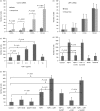Regulation of T-lymphocyte motility, adhesion and de-adhesion by a cell surface mechanism directed by low density lipoprotein receptor-related protein 1 and endogenous thrombospondin-1
- PMID: 24877199
- PMCID: PMC4008226
- DOI: 10.1111/imm.12229
Regulation of T-lymphocyte motility, adhesion and de-adhesion by a cell surface mechanism directed by low density lipoprotein receptor-related protein 1 and endogenous thrombospondin-1
Abstract
T lymphocytes are highly motile and constantly reposition themselves between a free-floating vascular state, transient adhesion and migration in tissues. The regulation behind this unique dynamic behaviour remains unclear. Here we show that T cells have a cell surface mechanism for integrated regulation of motility and adhesion and that integrin ligands and CXCL12/SDF-1 influence motility and adhesion through this mechanism. Targeting cell surface-expressed low-density lipoprotein receptor-related protein 1 (LRP1) with an antibody, or blocking transport of LRP1 to the cell surface, perturbed the cell surface distribution of endogenous thrombospondin-1 (TSP-1) while inhibiting motility and potentiating cytoplasmic spreading on intercellular adhesion molecule 1 (ICAM-1) and fibronectin. Integrin ligands and CXCL12 stimulated motility and enhanced cell surface expression of LRP1, intact TSP-1 and a 130,000 MW TSP-1 fragment while preventing formation of a de-adhesion-coupled 110 000 MW TSP-1 fragment. The appearance of the 130 000 MW TSP-1 fragment was inhibited by the antibody that targeted LRP1 expression, inhibited motility and enhanced spreading. The TSP-1 binding site in the LRP1-associated protein, calreticulin, stimulated adhesion to ICAM-1 through intact TSP-1 and CD47. Shear flow enhanced cell surface expression of intact TSP-1. Hence, chemokines and integrin ligands up-regulate a dominant motogenic pathway through LRP1 and TSP-1 cleavage and activate an associated adhesion pathway through the LRP1-calreticulin complex, intact TSP-1 and CD47. This regulation of T-cell motility and adhesion makes pro-adhesive stimuli favour motile responses, which may explain why T cells prioritize movement before permanent adhesion.
Figures








Similar articles
-
A cytokine-controlled mechanism for integrated regulation of T-lymphocyte motility, adhesion and activation.Immunology. 2013 Dec;140(4):441-55. doi: 10.1111/imm.12154. Immunology. 2013. PMID: 23866045 Free PMC article.
-
Antigen-induced regulation of T-cell motility, interaction with antigen-presenting cells and activation through endogenous thrombospondin-1 and its receptors.Immunology. 2015 Apr;144(4):687-703. doi: 10.1111/imm.12424. Immunology. 2015. PMID: 25393517 Free PMC article.
-
T-cell regulation through a basic suppressive mechanism targeting low-density lipoprotein receptor-related protein 1.Immunology. 2017 Oct;152(2):308-327. doi: 10.1111/imm.12770. Epub 2017 Jul 10. Immunology. 2017. PMID: 28580688 Free PMC article.
-
Receptor communication within the lymphocyte plasma membrane: a role for the thrombospondin family of matricellular proteins.Cell Mol Life Sci. 2007 Jan;64(1):66-76. doi: 10.1007/s00018-006-6255-8. Cell Mol Life Sci. 2007. PMID: 17160353 Free PMC article. Review.
-
Thrombospondin-1 Signaling Through the Calreticulin/LDL Receptor Related Protein 1 Axis: Functions and Possible Roles in Glaucoma.Front Cell Dev Biol. 2022 May 27;10:898772. doi: 10.3389/fcell.2022.898772. eCollection 2022. Front Cell Dev Biol. 2022. PMID: 35693935 Free PMC article. Review.
Cited by
-
Emerging functions of thrombospondin-1 in immunity.Semin Cell Dev Biol. 2024 Mar 1;155(Pt B):22-31. doi: 10.1016/j.semcdb.2023.05.008. Epub 2023 May 29. Semin Cell Dev Biol. 2024. PMID: 37258315 Free PMC article. Review.
-
The emerging roles of circular RNAs in vessel co-option and vasculogenic mimicry: clinical insights for anti-angiogenic therapy in cancers.Cancer Metastasis Rev. 2022 Mar;41(1):173-191. doi: 10.1007/s10555-021-10000-8. Epub 2021 Oct 18. Cancer Metastasis Rev. 2022. PMID: 34664157 Review.
-
Exosomes derived from LPS-stimulated human thymic mesenchymal stromal cells enhance inflammation via thrombospondin-1.Biosci Rep. 2021 Oct 29;41(10):BSR20203573. doi: 10.1042/BSR20203573. Biosci Rep. 2021. PMID: 34505627 Free PMC article.
-
Low Density Receptor-Related Protein 1 Interactions With the Extracellular Matrix: More Than Meets the Eye.Front Cell Dev Biol. 2019 Mar 15;7:31. doi: 10.3389/fcell.2019.00031. eCollection 2019. Front Cell Dev Biol. 2019. PMID: 30931303 Free PMC article. Review.
-
Functions of Thrombospondin-1 in the Tumor Microenvironment.Int J Mol Sci. 2021 Apr 27;22(9):4570. doi: 10.3390/ijms22094570. Int J Mol Sci. 2021. PMID: 33925464 Free PMC article. Review.
References
Publication types
MeSH terms
Substances
LinkOut - more resources
Full Text Sources
Other Literature Sources
Research Materials
Miscellaneous

